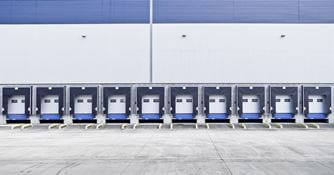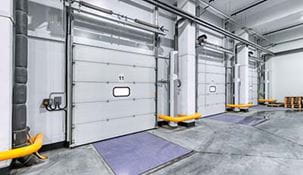Conveyor Systems | Phoenix

Conveyors can greatly improve the efficiency and productivity of your warehouse while reducing labor costs.
Raymond West Inc is the premiere warehouse automation supplier in Phoenix.
To speak with an automation expert, give us a call today at (602) 275-2228.
Automated conveyors and AS/RS implementations can boost the productivity of your storage operations, improve warehouse safety and substantially lower human resource costs.
Modern conveyors can move both individual cartons and entire pallets within your facility and they are a fundamental component of contemporary material handling design.
Conveyor systems can be grouped in three different classes for most material handling configurations:
- Powered belt or roller conveyors (for carton handling).
- Powered chain or roller conveyor systems (for pallet handling).
- Non-powered conveyors
Powered Package Handling Roller or Belt Conveyors
Powered belt or roller conveyors are generally used for less bulky items like packages and cartons.
Conveyor belts are usually used for advancing products along a line, while roller systems are used for collecting cartons in specific areas along the line.
Belt Conveyors
Used since the beginning of the 20th Century, conveyor belts are an indispensable piece of many material handling operations. Not as costly as roller options and oftentimes better suited to specific tasks like moving lighter weight products, belt conveyors have a place in most material handling designs.
Belt systems employ a long, looped belt that rides a series of non-powered rollers on a metal substructure called a slider belt. Motor driven pulleys turn the belt and move objects down the conveyor line.
Belts can be configured with a range of surfaces and materials in accordance with the function and nature of the conveyor. To illustrate, a conveyor belt surface may be totally flat in portions where products need to glide off the line and may have a gripping surface on segments where items have to be transported up inclines.
Roller Conveyors
While belt conveyors still have a place in most operations, newer roller conveyors feature a number of advantages in many modern material handling applications.
Most importantly, roller conveyors can enable collection of products on the line where belt configurations can not. This is a critical distinction because there are endless scenarios where objects must decelerate and accumulate in material handling applications. Common situations where accumulation is important are when products must be paused before being passed to automated palletizers or sorters.
Advanced roller conveyor systems also have the capability to supervise items on the line and apply zero pressure accumulation, meaning none of the amassed objects directly touch as they decelerate and finally stop.
Roller systems are comprised of several cylinder rollers that are generally set up in one of these ways:.
- Line-shaft conveyors: in a line shaft conveyor, a long steel shaft runs underneath the rollers at a right angle to them and is joined to each roller with flexible O-rings. A motor rotates the shaft, and thereby drives the cylinders by way of the connected O-rings. Line-shaft systems are the most cost efficient of all roller setups, but they can also demand the most service because the connections between the shaft and rollers need frequent readjustment and occasionally break.
- Belt-driven roller conveyors: As you would surmise from the name, belt-driven roller systems are driven by a belt that sits beneath the roller surface. A motor powers the belt, which propels the roller cylinders.
- MDR conveyors: Motorized roller conveyors, frequently called motor-driven roller (MDR) conveyors, are set up in sections where only one cylinder from each section is driven by it's own drive mechanism. That solitary powered cylinder is linked to the adjacent rollers in that section by way of flexible O-rings, and consequently powers all the rollers in the section. Powered units are placed in sequence to create the conveyor line.
MDR conveyors are very energy efficient for a couple of reasons: a.) they generally run on 24 volt DC motors and b.) these electric motors are set up to run only when an object is detected on the cylinders, and as a result they are idle much of the time.
Although motorized roller conveyers cost more than line-shaft and belt drive rollers, power expenses and service outlays are generally much lower than the other options mentioned. - Segmented belt conveyor: the principle of MDR systems eventually inspired the development of segmented belt conveyors. Similar to motor driven roller systems, segmented belts operate individually and offer several of the same benefits of motor driven rollers, including accumulation capabilities.
Powered Pallet Handling Conveyors
Powered pallet-handling conveyors are frequently used with automatic palletizers and AS/RS setups. Pallet handling conveyors can usually accommodate loads of up to 4,000 lbs and run at a far slower pace than carton handling conveyors, often at speeds as low as four pallets per minute.
Pallet-handling conveyors come in a couple of varieties: roller conveyors and chain conveyors.
- Pallet-handling chain conveyor: perhaps the simplest of all conveyor methods, pallets on a chain conveyor line are positioned on top of segments of heavy duty chain. Motors propel the lengths of chain which in turn advance the pallets down the line.
- Pallet-handling roller conveyor: comparable to MDR conveyors, pallet handling roller systems use large cylinders and heavy duty chains to connect the motorized cylinder to the remaining rollers in a conveyor section.
Non-Powered Conveyors
Skatewheel or roller conveyors are the most prevalent types of non-powered conveyors used in material handling. Non-powered rollers or skatewheels use gravity or inertia to move smaller items though pick modules, warehouses, automated sorters, workstations, loading docks and package sorting areas.
Skatewheel conveyors are made up of numerous individual wheels and need minimal energy to sustain the inertia of products as they move down a conveyor line. As a rule, they propel products faster than non-powered roller configurations and they have more adaptability when it comes to layout. Given that they're separate wheels instead of a belt, they are often put to use in curvilinear sections of a conveyor arrangement.
Generally non-powered roller configurations are not as expensive as skatewheel conveyor systems. They're often used for pick modules, workstations, and other zones where it's advantageous to have a level surface to perform tasks. They are also used to decelerate items that are coming from higher speed mechanisms like sorters so that human laborers can keep pace with conveyor output.
Non-powered skatewheel and roller systems have a significant disadvantage compared to powered conveyors: by applying inertia and gravity to move products you forego the option to control the force applied to those items. Put another way, you don't have control of the inertia and speed of materials on your conveyor line.
Conveyor System Engineering In Phoenix
If you 'd like a full analysis of conveyor system options for your warehouse, DC or other material handling operation, you can contact a professional at Raymond West Inc by calling (602) 275-2228.
2659 E Magnolia St
Phoenix, AZ 85034
(602) 275-2228
You May Also Like:

Conveyor Repair | Phoenix
Raymond West is a Phoenix warehouse automation equipment supplier. We offer repair and service for many types of conveyor systems. Call us today at (602) 275-2228.
Learn More

Warehouse Door Repair | Phoenix
Raymond West offers commercial overhead door service in Phoenix. Give us a call today at (602) 275-2228.
Learn More

Dock Doors
Raymond West supplies and services commercial overhead doors. We are backed by one of the largest service and parts operations in Arizona.
Learn More

$name
Raymond West Inc is a Phoenix supplier of loading dock equipment. We are backed by one of the largest service and parts operations in Arizona.
Learn More

